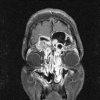The role of fungi in diseases of the nose and sinuses
- PMID: 23168148
- PMCID: PMC3904040
- DOI: 10.2500/ajra.2012.26.3807
The role of fungi in diseases of the nose and sinuses
Abstract
Background: Human exposure to fungal elements is inevitable, with normal respiration routinely depositing fungal hyphae within the nose and paranasal sinuses. Fungal species can cause sinonasal disease, with clinical outcomes ranging from mild symptoms to intracranial invasion and death. There has been much debate regarding the precise role fungal species play in sinonasal disease and optimal treatment strategies.
Methods: A literature review of fungal diseases of the nose and sinuses was conducted.
Results: Presentation, diagnosis, and current management strategies of each recognized form of fungal rhinosinusitis was reviewed.
Conclusion: Each form of fungal rhinosinusitis has a characteristic presentation and clinical course, with the immune status of the host playing a critical pathophysiological role. Accurate diagnosis and targeted treatment strategies are necessary to achieve optimal outcomes.
Conflict of interest statement
The authors have no conflicts of interest to declare pertaining to this article
Figures





Similar articles
-
Fungal Infections of the Sinonasal Tract and Their Differential Diagnoses.Surg Pathol Clin. 2024 Dec;17(4):533-548. doi: 10.1016/j.path.2024.07.003. Epub 2024 Aug 17. Surg Pathol Clin. 2024. PMID: 39489547 Review.
-
Complications of allergic fungal sinusitis.Am J Med. 2011 Apr;124(4):359-68. doi: 10.1016/j.amjmed.2010.12.005. Am J Med. 2011. PMID: 21435427
-
Fungus as the cause of chronic rhinosinusitis: the case remains unproven.Curr Opin Otolaryngol Head Neck Surg. 2009 Feb;17(1):43-9. doi: 10.1097/MOO.0b013e32831de91e. Curr Opin Otolaryngol Head Neck Surg. 2009. PMID: 19225305 Review.
-
Fungus: a role in pathophysiology of chronic rhinosinusitis, disease modifier, a treatment target, or no role at all?Immunol Allergy Clin North Am. 2009 Nov;29(4):677-88. doi: 10.1016/j.iac.2009.07.002. Immunol Allergy Clin North Am. 2009. PMID: 19879443 Review.
-
International Forum of Allergy & Rhinology. Editorial.Int Forum Allergy Rhinol. 2013 May;3(5):339-40. doi: 10.1002/alr.21175. Int Forum Allergy Rhinol. 2013. PMID: 23686834 No abstract available.
Cited by
-
Rhino-Orbito-Cerebral Mucormycosis: An Audit.Indian J Otolaryngol Head Neck Surg. 2022 Oct;74(Suppl 2):2686-2692. doi: 10.1007/s12070-020-02033-2. Epub 2020 Aug 9. Indian J Otolaryngol Head Neck Surg. 2022. PMID: 36452555 Free PMC article.
-
Preoperative Administration of Amphotericin B in Orbital Mucormycosis Management: A Case Report.J Neurol Surg Rep. 2025 Apr 11;86(2):e72-e76. doi: 10.1055/a-2558-6468. eCollection 2025 Apr. J Neurol Surg Rep. 2025. PMID: 40276688 Free PMC article.
-
Dental implant as a potential risk factor for maxillary sinus fungus ball.Sci Rep. 2024 Jan 30;14(1):2483. doi: 10.1038/s41598-024-52661-9. Sci Rep. 2024. PMID: 38291074 Free PMC article.
-
Sinonasal Fungal Infections and Complications: A Pictorial Review.J Clin Imaging Sci. 2016 Jun 14;6:23. doi: 10.4103/2156-7514.184010. eCollection 2016. J Clin Imaging Sci. 2016. PMID: 27403401 Free PMC article.
-
Evaluation of metagenomic next-generation sequencing (mNGS) combined with quantitative PCR: cutting-edge methods for rapid diagnosis of non-invasive fungal rhinosinusitis.Eur J Clin Microbiol Infect Dis. 2025 Jan;44(1):17-26. doi: 10.1007/s10096-024-04962-0. Epub 2024 Oct 23. Eur J Clin Microbiol Infect Dis. 2025. PMID: 39441336
References
-
- Hawksworth DL. The magnitude of fungal diversity: The 1.5 million species estimate revisited. Mycol Res 105:1422–1432, 2001.
-
- Green BJ, Sercombe JK, Tovey ER. Fungal fragments and undocumented conidia function as new aeroallergen sources. J Allergy Clin Immunol 115:1043–1048, 2005. - PubMed
-
- deShazo RD, Chapin K, Swain RE. Fungal sinusitis. N Engl J Med 337:254–259, 1997. - PubMed
-
- Catten MD, Murr AH, Goldstein JA, et al. Detection of fungi in the nasal mucosa using polymerase chain reaction. Laryngoscope 111:399–403, 2001. - PubMed
-
- Polzehl D, Weschta M, Podbielski A, et al. Fungus culture and PCR in nasal lavage samples of patients with chronic rhinosinusitis. J Med Microbiol 54:31–37, 2005. - PubMed
Publication types
MeSH terms
Substances
LinkOut - more resources
Full Text Sources
Medical

